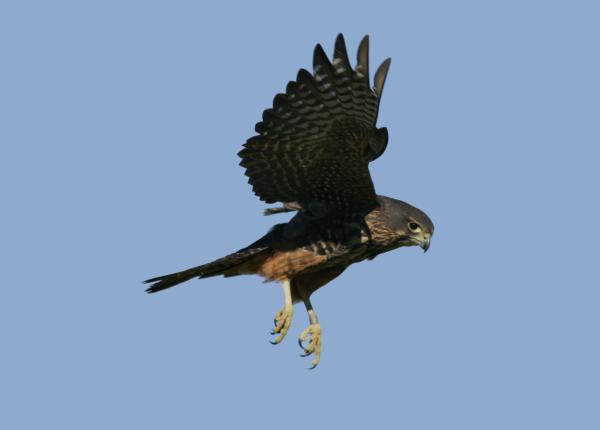Did You Know?
- The New Zealand Falcon is also known as Bush Hawk, New Zealand Hawk, New Zealand Bush Falcon, and Quail Hawk
- Males and females are known to hunt cooperatively in pairs.
- Though not unheard of in raptors, this falcon was observed feeding on the fruits of a low shrub called Leucopogon fraseri
How The Peregrine Fund is Helping
Though The Peregrine Fund does not work directly with New Zealand Falcons, our efforts in scientific research, habitat conservation, education, and community development help conserve birds of prey around the world. We also supply literature to researchers from our avian research library, which helps scientists around the world gather and share important information on raptor conservation. And, finally, our support of the Global Raptor Information Network gives raptor researchers tools to more efficiently conduct their own studies while contributing to a global program. It also provides citizen scientists a way to participate in raptor science and conservation.
Where They Live
Like the Galapagos Hawk, the Ridgway's Hawk, and the Mauritius Kestrel, the New Zealand Falcon is an endemic species. As it name suggests, it is found only in New Zealand. It lives in mosaics of forest and open country. If you ever travel to New Zealand, keep your eyes peeled for this lovely falcon. It often searches for prey near river valleys, forest clearings, at forest edges, or where emergent trees break through the canopy.
What They Do
The New Zealand Falcon is a diurnal, meaning it is active during daylight hours. It is known to occasionally visit urban gardens. This species does not migrate.
Why They Need our Help
The New Zealand Falcon is categorized as Near Threatened. This species is actually increasing in numbers in part of of its range, likely due to its ability to inhabit pine plantations and other modified habitats. However, it is decreasing in other parts of New Zealand. Researchers aren't exactly sure why.
What They Eat
Like most falcons, this lovely bird of prey mostly hunts other birds, such as seabird, pheasants, parakeets, and pigeons. However, it is an opportunistic hunter and will prey upon mammals, such as rabbits, hares, and stoats. It will also hunt reptiles, and insects, including dragonflies, beetles, and cicadas. It also occasionally takes advantage of carrion to get a quick meal.
Falcons are famous for their speed and powerful stoops (dives) onto unsuspecting prey. The New Zealand falcon uses this technique to hunt, as well as others. It might chase after its prey in an aerial pursuit, or snatch its quarry from the ground after hopping down from a low perch. It has also been known to rob nests from time to time.
Nests, Eggs, and Young
Like other falcons, the New Zealand Falcon does not build its own nest. Instead, it lays its eggs in scrapes or depressions in cliffs, slopes, or in epiphytes. Though not as common, it will also sometimes nest in a natural tree cavity. These falcons choose to place their nests in relatively open areas, and, more recently, in exotic tree (pine) plantations.
The female will lay between two and four eggs. They will need to be incubated for around one month or a few days longer. After the nestlings hatch they are covered in fluffy, white down. Around 33 days after hatching, the young birds will be ready to fly for the nest for the first time. The young birds will remain with their parents between 70 to 90 days before dispersing.
New Zealand Falcon and the World Center for Birds of Prey
Though we don't house any New Zealand Falcons at the World Center for Birds of Prey, we have a number of interesting falcon species that serve as avian ambassadors during presentations and flight shows. American Kestrels, Peregrine and Aplomado Falcons, among others, can be seen at our center. We also offer many other fun ways to learn about birds of prey. The visitor center has interactive displays, tours, interesting videos and a children's room with activities from coloring sheets to quizzes to costumes and a touch table for the curious mind. Knowledgeable staff and volunteers are on hand to answer any questions you may have about New Zealand Falcons or any other bird of prey.
References:
Debus, S., G. M. Kirwan, and D. A. Christie (2020). New Zealand Falcon (Falco novaeseelandiae), version 1.0. In Birds of the World (J. del Hoyo, A. Elliott, J. Sargatal, D. A. Christie, and E. de Juana, Editors). Cornell Lab of Ornithology, Ithaca, NY, USA. https://doi.org/10.2173/bow.nezfal1.01
Global Raptor Information Network. 2022. Species account: New Zealand Falcon Falco novaeseelandiae. Downloaded from http://www.globalraptors.org on 31 Mar. 2022










